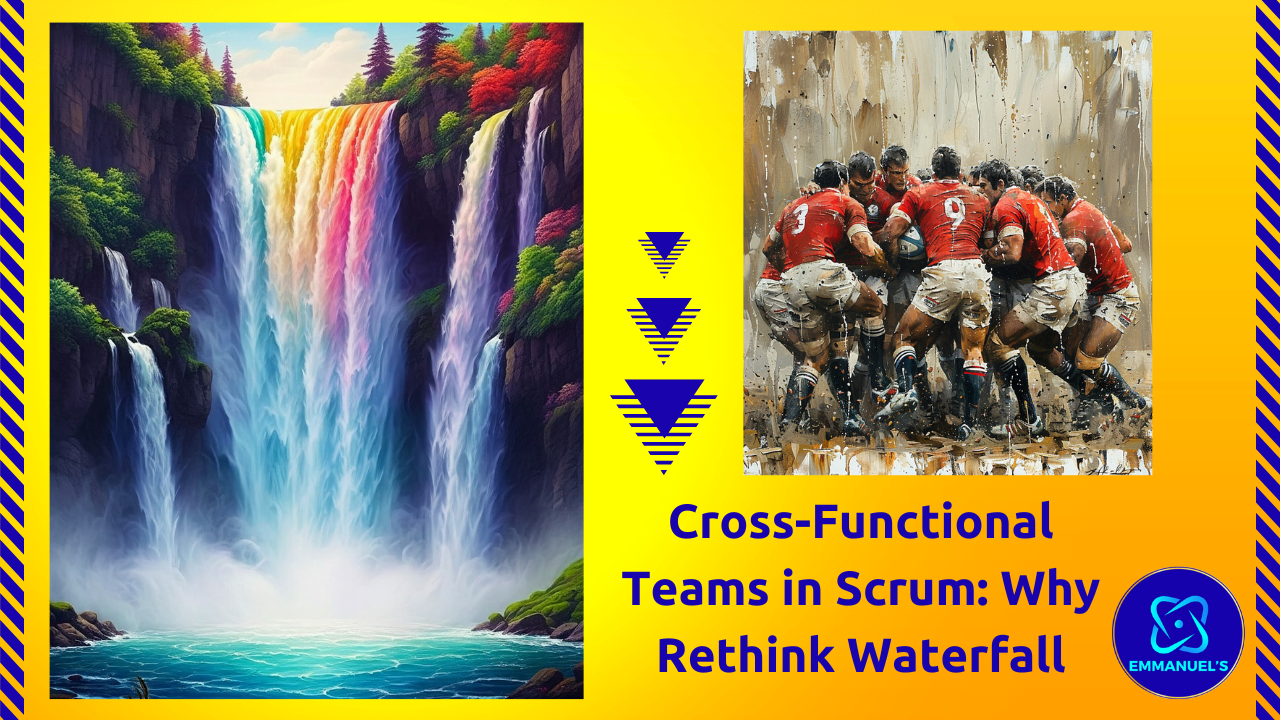Cross-Functional Teams in Scrum: Why Rethink Waterfall
In a world where change is constant, Agile transcends the rigidity of Waterfall. Embrace cross-functional Scrum teams for transparency, adapt swiftly to feedback, and foster efficient product delivery, enabling your organization to thrive in the competitive landscape.

Does the rigid pace of Waterfall bog down your project?
In today’s complex world, traditional project management methods struggle to keep up.
Discover how cross-functional Scrum teams embrace agility, foster seamless collaboration, and consistently deliver value, allowing you to outperform the competition—your market differentiator.
Why Rethink Waterfall: What It Means for a Scrum Team to Be Cross-Functional
The Waterfall process is primarily a rigid, step-by-step approach to projects. It’s like trying to navigate a speedboat through a narrow canal: slow, inflexible, and prone to running aground.
In our dynamic startup and SME world, where change is the only constant, Waterfall just doesn’t cut it. Its sequential nature means specialists work in isolation, passing work like a baton, leading to delays and missed opportunities for real-time problem-solving.
This siloed approach is precisely why modern organizations are seeking a better way.





What It Means for a Scrum Team to Be Cross-Functional
The Agile Advantage: Why Organizations Are Rethinking Traditional Project Management
Enter Agile. An elegant, responsive approach that entrusts startups and SMEs (Small and Medium Enterprises) to adapt, iterate, and deliver value with efficiency.
Think of it as a sleek, adaptable vessel, perfectly ready to navigate the choppy waters of our competitive world.
At its heart, Agile thrives on cross-functional teams–a key distinction from Waterfall’s segmented approach.
Why Agile is Essential for Startups and SMEs
Agile’s core benefits are deeply rooted in its Team structure:
- Embrace Change: Agile methodologies thrive on change, enabling organizations to pivot timely in response to customer feedback and market shifts. For instance, if a fitness app organization had invested heavily in a long development cycle only to find users wanted a social component, a Waterfall approach would suffer significant rework. An Agile, cross-functional Team, however, would have identified this need early through continuous feedback, incorporating it seamlessly and saving time and resources.
- Deliver Value Consistently: Agile focuses on delivering incremental value, ensuring products reach the market and gather user feedback early. Imagine a food delivery service using Agile: a cross-functional Team launches a basic menu, then rapidly expands based on user preferences. The collaborative approach, where all necessary skills are present within the Team, becomes a recipe for transparent, consistent growth.
- Foster Collaboration: Agile inherently fosters collaboration between developers, designers, testers, and stakeholders. Cross-functional teams break down traditional silos, promoting a shared understanding of goals and challenges. Picture a unified “command center,” where Team members with diverse expertise adopt challenges and celebrate wins together as a single, efficient asset. This direct, continuous interaction eliminates hand-off delays and improves communication and efficiency.
Agile in Action: A Spotify Case Study
Spotify, the music streaming giant, epitomizes Agile success. They leveraged Scrum, a popular Agile framework, to entrust their cross-functional teams to work autonomously, experiment, and deliver new features rapidly.
This empowered, integrated Team structure enabled them to stay ahead of the curve and dominate the music streaming market, demonstrating the ability to move beyond rigid, sequential processes.
Agile Methodology: The Speedboat of Project Management
Understanding the fundamental differences between traditional and modern approaches highlights why cross-functional teams are indispensable.
Waterfall:
- Rigid, Sequential Process: Follows a linear, step-by-step approach, with phases completed one after another.
- Limited Flexibility: Modifying an earlier phase is challenging, resulting in delays and increased costs.
- Emphasis on Upfront Planning: Requires extensive planning and documentation at the outset, often before a complete understanding of evolving needs exists.
- Delayed Feedback: Feedback is typically gathered at the end of each phase, making it challenging to adapt to changing requirements.
Agile (and its Cross-Functional Core):
- Iterative and Flexible: Breaks down projects into smaller, manageable iterations, allowing for continuous adaptation and refinement.
- Welcomes Change: Embraces changing requirements driven by innovation and creativity, adjusting accordingly based on customer feedback and market shifts.
- Focus on Collaboration (via Cross-Functional Teams): Emphasizes direct collaboration within cross-functional teams, promoting communication and shared understanding among all necessary skill sets.
- Continuous Feedback: Encourages regular feedback loops throughout development, ensuring alignment with customer needs and project goals.
- Efficient and Consistent Value Delivery: Delivers incremental value throughout the project, allowing for quicker time-to-market and constant validation.
While Waterfall linearly prioritizes upfront planning and documentation, Agile is a flexible, iterative approach that emphasizes the power of continuous feedback, rapid value delivery, and, critically, collaboration conducted by cross-functional teams.
Debunking Myths About Cross-Functional Teams
Misconceptions exist about what cross-functional teams truly represent in Agile product development. Contrary to popular belief, a cross-functional Scrum Team doesn’t require every Team member to be a generalist with identical abilities.
The Scrum Guide clarifies that a Scrum Team is cross-functional when individuals with diverse skills collectively possess all necessary expertise to create value with each Sprint. It means the Team, as a whole, has the capabilities to handle all aspects of product development without external dependencies.
Specialists, such as business analysts, developers, and testers with unique, in-depth skills, are invaluable, as long as the collective skills within the Team cover all aspects of product development and they contribute to the Team's shared goal.
Another common myth is that the Scrum Master or Product Owner assigns tasks based on individual expertise. In truth, Scrum Teams are self-organizing. It empowers the Team itself to decide how best to approach the Product Backlog items to achieve the Sprint Goal.
The development Team within a cross-functional Team collaboratively determines how to apply their collective skill set to the product development process, minimizing external reliance.
In essence, a cross-functional Scrum Team consists of individuals with complementary skills who, together, possess all the necessary expertise to deliver working product increments without necessarily relying on outside resources.
They are self-organizing units where each member contributes their expertise from different functional areas, promoting seamless collaboration within the Team.
Key Takeaway
In our competitive business landscape, startups and small to medium-sized enterprises (SMEs) embrace agility to thrive.
Agile methodologies, particularly Scrum with its emphasis on cross-functional teams, enable organizations to respond effectively to change, accelerate the delivery of product value, and foster deep collaboration among teams.
It ultimately leads to a significant competitive advantage and a clear market differentiator.
By rethinking the rigid Waterfall approach and adopting Agile principles, businesses navigate the complexities of the market efficiently and with flexibility.
It ensures they stay ahead of the curve and achieve their sustainable business goals by leveraging the collective power of integrated, self-organizing teams.
Conclusion of Rethinking Waterfall
In conclusion, shifting away from the Waterfall methodology in favor of Agile approaches, particularly those driven by cross-functional teams, revolutionizes the product development process.
This integrated Team structure allows members with complementary skills to contribute diverse expertise, enabling the Team to address challenges efficiently and consistently deliver valuable product increments every Sprint.
Modern teams are self-organizing and cross-functional, enabling them to tackle complex problems within a single project or product. Understanding these teams debunks the myth of needing all generalists, instead highlighting the strength of a collective, diverse set of skills.
It eliminates the need for siloed handoffs, creating adaptable and responsive organizations capable of achieving high-quality results that meet customer needs.
Ready to Revolutionize Your Projects?
Regardless of your current project challenges, here are the resources that assist you in achieving dynamic, sustainable success with Agile and Scrum.
Unlock Expert Insights and Community
- Join the Scrum Whisperer’s Free Forever Membership today! Get access to guidance on mastering cross-functional Scrum teams for superior project delivery in sustainable development.
- Free Forever Membership
Discover Practical Strategies
- Need to improve project management? Download your FREE eBook Preview: Strategies for Success. Get actionable insights you could use immediately.
- Ready for the complete blueprint to transform your approach? Buy the full eBook: Achieve Business Success with Efficient Project Management to master Agile methodologies from the ground up.
Is Your Project in Trouble?
- Suppose your project is off-track and needs urgent attention to achieve sustainable, consistent, and efficient product delivery. In that case, I designed our specialized Scrum Master Project Rescue Service to provide in-depth details about implementing cross-functional Scrum and get back on track.
- Turn Your Project Around with Sage Scrum Master Guidance!





